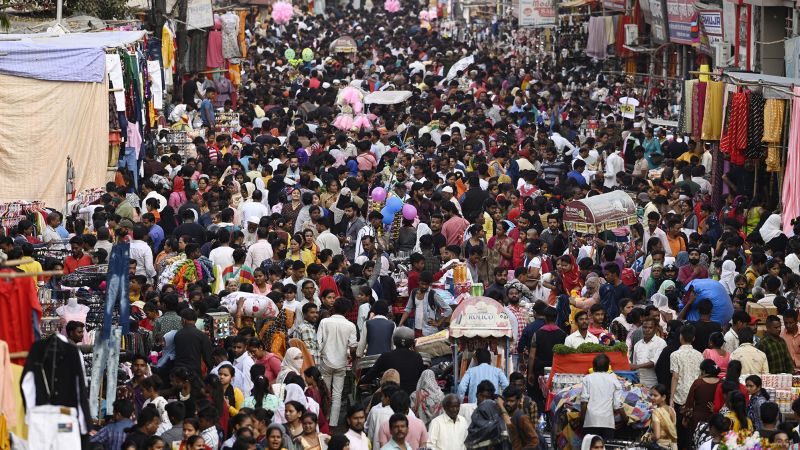According to the United Nations, the global population is projected to hit 8.045 billion by mid-2023. India has overtaken China as the most populous nation in the world, with a population of 1.4286 billion compared to China’s 1.4257 billion.

Also Read: SpaceX’s Starship Rocket Debut Launch Postponed: What You Need to Know
The report suggests that India’s population is expected to continue to increase for nearly three decades before peaking at 1.65 billion and then starting to decline.
Factors influencing population growth include fertility rates, increasing longevity, and international migration.
The UN’s World Population Prospects report predicts that global fertility is projected to fall from 2.3 children per woman in 2021 to 2.1 in 2050.
Life expectancy at birth is expected to rise globally from 72.8 years in 2019 to 77.2 years in 2050. While international migration is a smaller component of population change than births or deaths, it can still have a significant impact on population size in some countries and areas.
Gender equality, empowerment, and advancing greater bodily autonomy for women and girls are seen as determinants for a sustainable future, according to the United Nations Population Fund.
The agency suggests that women and girls should be at the center of sexual and reproductive policies and programs to unlock a future of infinite possibilities.
According to the United Nations Population Fund’s (UNFPA) newly released report, India has overtaken China to become the world’s most populous nation.
The report reveals that India’s population has reached 1,428.6 million while China’s stands at 1,425.7 million, a difference of 2.9 million.
This marks a milestone in India’s population growth, which has grown by more than one billion people since 1950, the year the UN began gathering population data.
The UNFPA report highlights that future population growth is highly dependent on the path that future fertility will take.
The World Population Prospects (2022) shows that global fertility is projected to fall from 2.3 children per woman in 2021 to 2.1 in 2050.
As the report suggests, this could have a significant impact on India’s population growth as well. Several studies have shown that India’s population is expected to increase for nearly three decades before it peaks at 165 crore. It will then start to decline, as per reports.
The UNFPA report also provides insight into the age structure of India’s population. In India, 25% of the population constitutes children aged 0-14, 18% are those aged 10-19 years, 26% belong to the 10-24 age bracket, and 68% are in the 15-64 age group.
Seven percent of the country’s population is above 65 years of age. These figures reveal that India has a younger population as compared to China.
Experts suggest that regional disparities exist in India’s population. States such as Kerala and Punjab have an ageing population, while Uttar Pradesh and Bihar have a younger population. This disparity can impact India’s population growth in the future.
The UNFPA report also highlights that significant gains in life expectancy have been achieved in recent years.
Globally, life expectancy at birth is expected to rise from 72.8 years in 2019 to 77.2 years in 2050. This increase in longevity can have a significant impact on population growth in India as well.
While international migration is a much smaller component of population change than births or deaths, in some countries and areas, the impact of migration on population size is significant.
Also Read: ChatGPT Banned in Multiple Countries: Reasons and Consequences for OpenAI
Between 2010 and 2021, seventeen countries or areas will see a net inflow of more than one million migrants, while ten countries will see a net outflow of a similar magnitude.
The UNFPA report also stresses the importance of ensuring gender equality, empowerment, and advancing greater bodily autonomy for women and girls.
According to the report, women and girls should be at the center of sexual and reproductive policies and programs. Only when the rights, choices, and equal value of all people are truly respected and held, can we unlock a future of infinite possibilities.
Despite the challenges that come with population growth, the UNFPA report suggests that India’s 1.4 billion people must be seen as 1.4 billion opportunities.
As the country with the largest youth cohort, its 254 million youth (15-24 years), India can be a source of innovation, new thinking, and lasting solutions.
However, this potential can only be realized if women and girls are equipped with equal educational and skill-building opportunities, access to technology and digital innovations, and most importantly, with information and power to fully exercise their reproductive rights and choices.
Moreover, the report stresses the importance of gender equality, reproductive rights, and empowering women and girls to unlock the potential of India’s youthful population.
Ultimately, India’s population should be viewed as an opportunity for innovation and progress, but it is essential to ensure that all individuals have access to the resources and opportunities needed to achieve their full potential.
Also Read: Nokia’s 4G Network to Support NASA’s Artemis 1 Mission and Future Lunar Expeditions
/cloudfront-us-east-2.images.arcpublishing.com/reuters/3A7VWUTMJZMJXOXH6ZY3EBV6U4.jpg)




